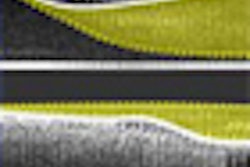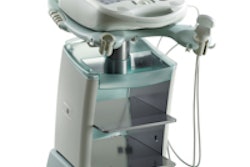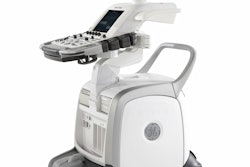Despite recent safety warnings, ultrasound contrast agents are safe and effective for assessing patients during echocardiography, concludes a massive review of more than 42,000 patients examined at three institutions in the U.S.
The retrospective study, which appears in this month's Journal of the American College of Cardiology, found no significant differences in death rate or myocardial infarction (MI) between patients who received ultrasound contrast agents and those who did not during stress echocardiography.
In 2007, the U.S. Food and Drug Administration (FDA) mandated the placement of a black box warning for ultrasound contrast agents Definity from Lantheus Medical Imaging (North Billerica, MA) and Optison from GE Healthcare (Chalfont St. Giles, U.K.), following reports of 11 deaths that occurred around the time of their administration.
The warning was modified in July 2008 to exclude only the most unstable patients from use of the agents. However, many institutions had long since stopped using echo contrast, a product that proponents believe significantly improves the quality of many exams that would otherwise be unreadable.
Echo contrast's utility was highlighted in this month's JACC article, authored by Dr. Melda Dolan, from Saint Louis University Hospital in Missouri, as well as colleagues from University of Nebraska Medical Center in Omaha and the Mayo Clinic in Rochester, MN (JACC, January 2009, Vol. 53, pp. 32-38).
"Unfortunately, up to 30% of studies are deemed technically difficult due to poor image quality, making these studies very challenging to interpret," the authors wrote. "Patients with large body habitus, chest wall deformities, and severe chronic lung disease are at higher risk of having suboptimal image quality. Furthermore, bedside echocardiograms are frequently ordered to identify the cause of hemodynamic instability and respiratory failure in critically ill patients."
But while the deaths reported prior to the black box warning (10 from Definity, one from Optison) were temporally related to use of the agents, no causal link was ever found, and many researchers believe that none exists.
"As has been the case, serious adverse events (death or nonfatal MI) within 24 hours of contrast use could be easily explained by the patient's underlying condition at the time of the study or to induced ischemia during stress echocardiography," the authors wrote.
Single-center studies had shown no additional morbidity or mortality resulting from use of the agents; however, their safety had not been comprehensively reviewed in a multicenter setting, Dolan and colleagues wrote. Therefore, the present study aimed to comprehensively define the risks and benefits of ultrasound contrast agents in patients undergoing stress echocardiography.
The group analyzed the records of 42,408 patients at three different institutions who had baseline suboptimal images and/or underwent nuclear myocardial perfusion imaging and received contrast agents between 1999 and 2007. Of these, 18,749 had stress echocardiography exams. Measured outcomes included death and myocardial infarction within 30 minutes, 24 hours, or during long-term follow-up.
Results
There were no deaths or MIs among the 23,659 patients who received contrast for suboptimal resting studies or myocardial perfusion studies. There was one death and five nonfatal MIs within 24 hours of contrast administration.
"This was not different from a matched cohort of 15,989 patients not receiving contrast," Dolan and colleagues wrote. "In the matched group of 5,900 consecutive patients with optimal resting studies and no contrast use, no events occurred within 30 minutes, but seven nonfatal MIs and one death occurred within 24 hours."
Among the 18,749 patients who underwent stress echocardiography, there were no deaths or MIs within 30 minutes, and there was one death and five nonfatal MIs (three after Definity, two after Optison) within 24 hours.
There was no reason to believe that the use of contrast agents contributed to any of the MIs, or to the death of the stress echocardiography patient, who had developed frequent runs of ventricular tachycardia requiring intravenous antiarrhythmic therapy, according to the authors. This patient eventually developed disseminated intravascular coagulation. On day 11, dobutamine stress echocardiography and real-time myocardial contrast echocardiography with Optison contrast were performed without complication, but within 24 hours the patient developed recurring ventricular tachycardia and died 22 hours after contrast administration.
Similarly, at 30 days there were no statistically significant differences between patients undergoing dobutamine stress echocardiography or exercise stress electrocardiography with or without contrast.
In the 10,788 patients who received contrast, 37 (0.34%) died and 68 (0.63%) experienced an MI. In a matched cohort of 15,989 patients who did not receive contrast, there were 62 (0.39%) deaths and 73 (0.46%) MIs.
Additionally, there were no significant differences in 4,011 patients who received contrast for suboptimal image quality during echocardiography versus a matched group of 1,923 patients who had optimal images and did not require contrast.
"Endocardial border visualization in patients with suboptimal images resulted in comparable sensitivity (81% vs. 73%) and diagnostic accuracy (82% vs. 77%) for wall motion analysis compared with patients with optimal image quality," the authors wrote. "At long-term follow-up, abnormal wall motion and/or myocardial perfusion predicted adverse outcomes (20.6%) when compared with patients with normal studies (3.7%)."
Image quality improved with contrast use
Significant incremental value was derived from contrast use at all three participating centers, which used contrast-enhanced left ventricular opacification to yield sensitivity and specificity equivalent to that of patients who had optimal image quality without contrast, the authors wrote.
"The ability of stress echocardiography to detect coronary artery disease is clearly related to the ability to visualize all myocardial segments in each coronary artery territory," they wrote.
When echo studies need to be cancelled due to suboptimal windows and contrast is not available, the alternative tests usually involve the use of ionizing radiation and additional costs and risk to the patient, they added.
In addition, myocardial perfusion imaging with contrast, though not yet FDA approved, added significant incremental value to dobutamine stress echocardiography, the group wrote.
The study was large, but its retrospective design was a limitation, and different cohorts were used to compare patients who received contrast with those who did not, the authors noted.
"The risks of both short-term and long-term events, defined as nonfatal MI and death, after contrast administration are very low and are no different than in patients not receiving contrast during stress echocardiography," Dolan and colleagues concluded. "Contrast use in patients with suboptimal images improves feasibility and accuracy of stress echocardiography testing. Failure to use contrast agents in patients with suboptimal images may result in a misdiagnosis and/or additional alternative imaging techniques with greater inherent risks."
Experience in this and other recent studies comprising more than 60,000 patients demonstrates that "there is no evidence to suggest a causal relationship between the use of commercially available contrast and serious adverse events," they wrote. "The findings in this study provide physicians with the confidence to use contrast agents during stress testing when clinically indicated."
By Eric Barnes
Auntminnie.com staff writer
January 8, 2009
Related Reading
Lantheus touts positive Definity results, December 16, 2008
ASE issues echocardiography contrast consensus statement, November 11, 2008
Lantheus scores Premier contract, October 24, 2008
Lantheus to license Bracco's CardioGen PET tracer, September 24, 2008
Definity echo contrast agent lands on FDA drug safety list, September 8, 2008
Copyright © 2009 AuntMinnie.com



















